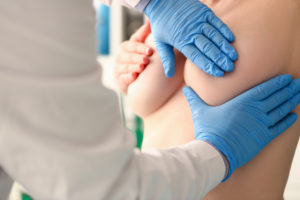The clinical breast examination, or CBE, is an important piece of our recommended three-pronged approach to the early detection of breast cancer that we talk about in our breast health workshops.
Clinical breast exams often receive less attention than their partners-in-health, the monthly breast self-exam and the annual mammogram, although they are just as crucial to breast health.
What is a Clinical Breast Exam?
Essentially, during a clinical breast exam a health professional, either a doctor or nurse, performs a thorough physical examination of your breasts. They will carefully examine your breasts and the surrounding area for any irregularities, much as you do when completing your own monthly breast self-exam.
Who Should Receive a Clinical Breast Exam, and When?
Women under 40 with normal risk factors for breast cancer should receive a clinical breast exam at least once a year, by age 19. Most gynecologists will include the exam as part of your annual “well woman” visit.
Young women with heightened risk factors, such as family history, should ask their family doctor about when it is appropriate to begin clinical breast exams.
The Maurer Foundation recommends that women over forty schedule their clinical breast exam and their annual mammogram six months apart. This ensures that you will be examined by a health care professional twice a year.
Additionally, anytime you notice irregularities during your monthly breast self-exam, then it is time to schedule a clinical breast exam to follow up.
How Should You Prepare for a Clinical Breast Exam?
The only thing you need to do (other than showing up, of course) is keep your health professional informed of the state of your breasts. Let them know before the exam:
- If you have noticed any changes in your breasts
- If you might be pregnant or are breast-feeding
- If you have breast implants
- If you are experiencing any breast pain or discomfort
- If you have detected any irregularities during your own breast self-exams
How is a Clinical Breast Exam Administered?
You can expect to privately undress, and will likely wear a gown that opens in the front. After talking briefly about your medical history and discussing any questions, the health professional will methodically apply pressure and feel around your breast, underarm, and chest area for any possible lumps, dense breast tissue, signs of infection, or any other irregularities.
Your health care provider should examine you both lying down and sitting up, since the breasts look and feel entirely different in each position. The doctor may ask you to lean forward, raise your arms above your head, or move in different ways to ensure they are performing the most accurate exam.
Clinical Breast Exam Tips
This is also the perfect time to ask your health care provider about your own breast self-exam habits, and make sure you are using the proper techniques every month. After all, your doctor or nurse should be your primary ally in taking charge of your health!

